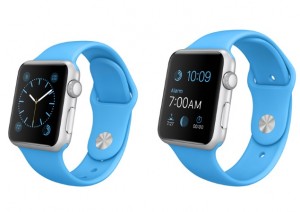A report citing people with knowledge of the Apple Watch’s development has detailed the company’s targets for the Apple Watch battery. It also stresses that Apple might “fall short of those targets.”
9to5mac sources suggest that Apple picked a powerful processor and a “high-quality” screen for the Apple Watch that contribute to significant power drain. It adds that the Apple Watch uses a toned-down version of iOS (codenamed SkiHill), packs an Apple S1 chip, which delivers performance similar to the Apple A5 chip used by the current generation iPod touch, and features a Retina-class colour display that is capable of outputting 60fps.
The report suggests that Apple initially aimed for the Watch to provide about one full day of mixed usage, including a bit of active use and primarily passive use.
“As of 2014, Apple wanted the Watch to provide roughly 2.5 to 4 hours of active application use versus 19 hours of combined active/passive use, 3 days of pure standby time, or 4 days if left in a sleeping mode,” noted the report.
The sources however claim that the company is unlikely to achieve that target with the first generation of devices, and is said to be likely only achieve up to 2-3 days of battery life in either the standby or sleeping low-power modes.
The company has reportedly been stress-testing the Apple Watch’s battery life with a number of preloaded and third-party apps. The sources add that Apple is targeting up to 2.5 hours of “heavy” application usage that will include “processor-intensive gameplay, or 3.5 hours of standard app use.”
The company has been expecting that the Apple Watch will offer better battery life figures with fitness tracking software, providing roughly 4 hours of active tracking.
Earlier reports have revealed that the Apple Watch will come with various modes and the sources add that the company has been running several tests to check the battery life of the wearable device in time-keeping mode.
Additionally, sources claim that Apple has circulated large number of Apple Watch devices (around 3,000) and mainly the stainless steel variant to be tested in real-world performance in various situations.
Lastly, the sources suggest that the company is also working on MagSafe-based inductive charging mechanism for the Apple Watch.
Reportedly, Apple has developed two circular charges – a plastic and another stainless steel version. As of now, there is no word whether Apple will rollout both the versions into the market, but may do so for different variants of the smartwatch at different price bands.
Apple launched its first wearable device, the Apple Watch, alongside the iPhone 6 andiPhone 6 Plus in September last year. The company initially promised an “early 2015 launch,” though we are yet to hear any updates on the rollout of the Apple Watch from the company. Recent reports peg a March release however.
Reports have also been claiming that one of the major reasons for the delay has been the battery life of the Apple Watch, something 9to5Mac also corroborates in its report. In September, an Apple spokeswoman tipped that the battery life of the Apple Watch was “about a day” without revealing the expected battery life, adding that Apple anticipated consumers to charge the smartwatch once daily. A recent leak detailed the new Apple Watch ‘companion’ app that is said to be made for the iPhone.








